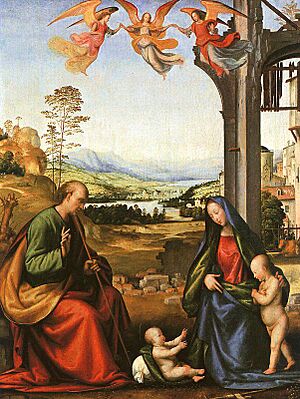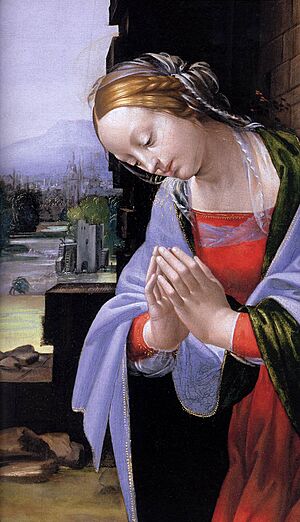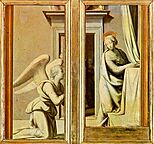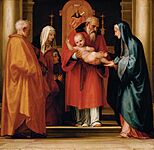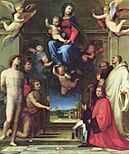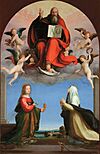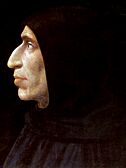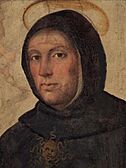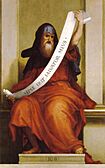Fra Bartolomeo facts for kids
Quick facts for kids
Fra Bartolomeo
|
|
|---|---|
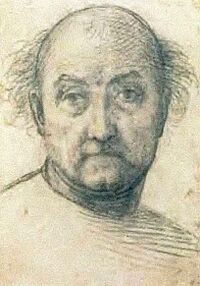
Presumed portrait of Fra Bartolomeo
|
|
| Born |
Baccio della Porta
28 March 1472 |
| Died | 31 October 1517 (aged 45) |

Fra Bartolomeo (born 28 March 1472 – died 31 October 1517) was a famous Italian Renaissance painter. His real name was Baccio della Porta. He was known for painting religious scenes.
Fra Bartolomeo spent most of his life in Florence. He later traveled to other cities, including Rome. He learned to paint from Cosimo Rosselli. In the 1490s, he was inspired by Girolamo Savonarola, a religious leader. This led him to become a Dominican friar in 1500. For a few years, he stopped painting.
In 1504, his religious order asked him to start painting again. He then developed a beautiful and grand style, typical of the High Renaissance. His painting Vision of St Bernard from that time shows this new style. It is said that this painting greatly impressed the young artist Raphael. Fra Bartolomeo and Raphael became good friends and influenced each other's art.
Fra Bartolomeo's portrait of Savonarola is still the most famous image of the reformer. He painted using both oils and fresco (paintings on wet plaster). Some of his drawings are early examples of pure landscape sketches by an Italian artist.
Life of Fra Bartolomeo
Fra Bartolomeo was born in Savignano di Prato, a town in Tuscany, Italy. He got the nickname "Baccio della Porta" because his house was near a city gate called San Pier Gattolini. "Porta" means "gate" in Italian.
Around 1483 or 1484, he started learning to paint. He became an apprentice in the workshop of Cosimo Rosselli. In 1490 or 1491, he began working with another artist named Mariotto Albertinelli.
In the late 1490s, Baccio became interested in the teachings of Girolamo Savonarola. Savonarola believed that much of the art at the time was too fancy and not religious enough. He thought art should help people understand the Bible. Fra Bartolomeo's famous portrait of Savonarola, painted in 1498, is now in the Museo Nazionale di San Marco in Florence.
The next year, he was asked to paint a large fresco called Universal Judgement. But on July 26, 1500, he became a Dominican friar. His friends Albertinelli and Giuliano Bugiardini finished the fresco for him. The following year, he moved into the San Marco convent.
Fra Bartolomeo stopped painting for several years. He only started again in 1504 when his religious leader told him to. He became the head of the monastery's art workshop. That year, he started his Vision of St. Bernard painting, which he finished in 1507.
Soon after, the famous artist Raphael visited Florence. He became friends with Fra Bartolomeo. Bartolomeo learned about perspective (making things look 3D) from Raphael. In return, Raphael learned about using colors and painting clothes (drapery) from Bartolomeo. They remained very good friends.
In early 1508, Bartolomeo went to Venice. He painted a work called Holy Father, St. Mary Magdalene and St. Catherine of Siena. He was influenced by the bright colors used by Venetian artists. However, the Dominicans in Venice did not pay him for the painting. So, he took it back to Lucca, where you can see it today. In Lucca, in 1509, he also painted an altarpiece (a painting behind an altar) with Albertinelli for the local cathedral.
In 1513, he traveled to Rome. There, he painted Peter and Paul, which is now in the Pinacoteca Vaticana. In the years that followed, he painted St. Mark Evangelist (now in Palazzo Pitti in Florence) and frescoes in a Dominican convent near Florence. His last known work was a fresco called Noli me tangere.
Fra Bartolomeo died in Florence in 1517.
Fra Bartolomeo's Art Style

When he first started, Fra Bartolomeo's paintings showed the influence of his teacher's assistant, Piero di Cosimo. He was also inspired by artists like Domenico Ghirlandaio and Filippino Lippi. After his break from painting (1500-1503), his style changed. He learned from Raphael how to show light and its effects on moving figures.
Fra Bartolomeo often painted figures that were a bit small and covered in flowing clothes. Some people thought this was a weakness in his art. To show he could paint differently, he created the amazing St Mark Evangelist, which is considered his best work. He also painted a very realistic Saint Sebastian. This painting showed so much pain that it had to be moved from a chapel because it was too intense for people to see.
Fra Bartolomeo's paintings are known for how well he used light and shadow. They also have rich and delicate colors. The way he painted clothes on his figures was excellent. He was one of the first artists to use a "lay-figure" (a jointed wooden doll) to help him draw and paint clothes more realistically.
Some of his students included Cecchino del Frate, Benedetto Ciamfanini, Gabriel Rustici, Ridolfo Ghirlandaio, and Fra Paolo Pistolese.
Famous Works
- Assumption of Mary (1508) - This painting was destroyed in 1945.
- Madonna in Glory with Saints (1512, with Albertinelli) - You can see this in the Cathedral of Besançon.
- Christ Supported by Two Angels (around 1514) - Located in Casa Vasari, Arezzo.
- St. Sebastian (1515) - This painting is in the Alaffre Collection in Pézenas, France.
- Religious works
-
Annunciation (1500)
Galleria degli Uffizi, Florence -
Scene with Christ in the Temple (1516), Kunsthistorisches Museum, Vienna
-
God the Father with Sts Catherine of Siena and Mary Magdalene, National Museum of Villa Guinigi
- Portraits, details
See also
 In Spanish: Fray Bartolomeo para niños
In Spanish: Fray Bartolomeo para niños


